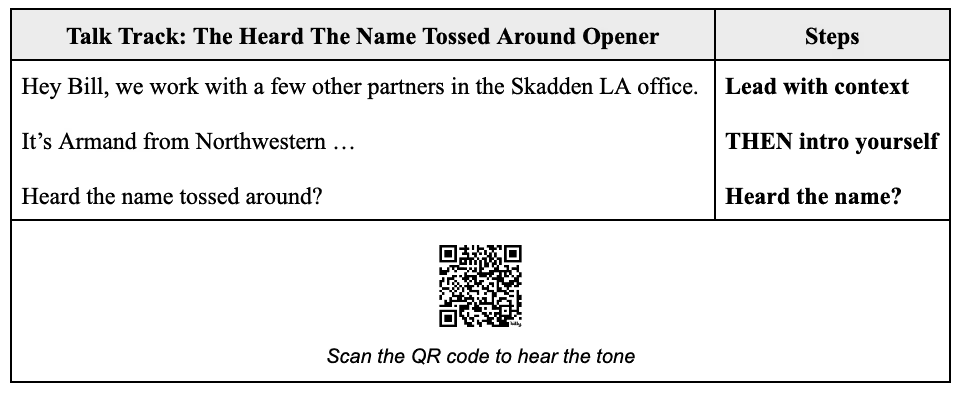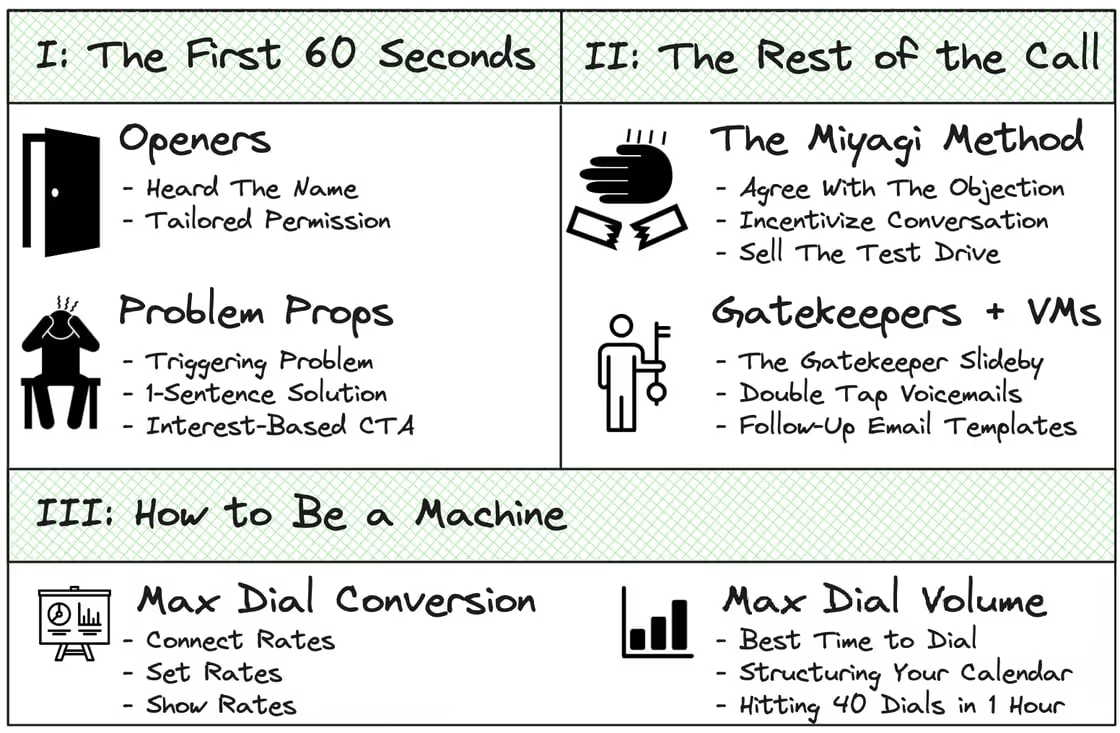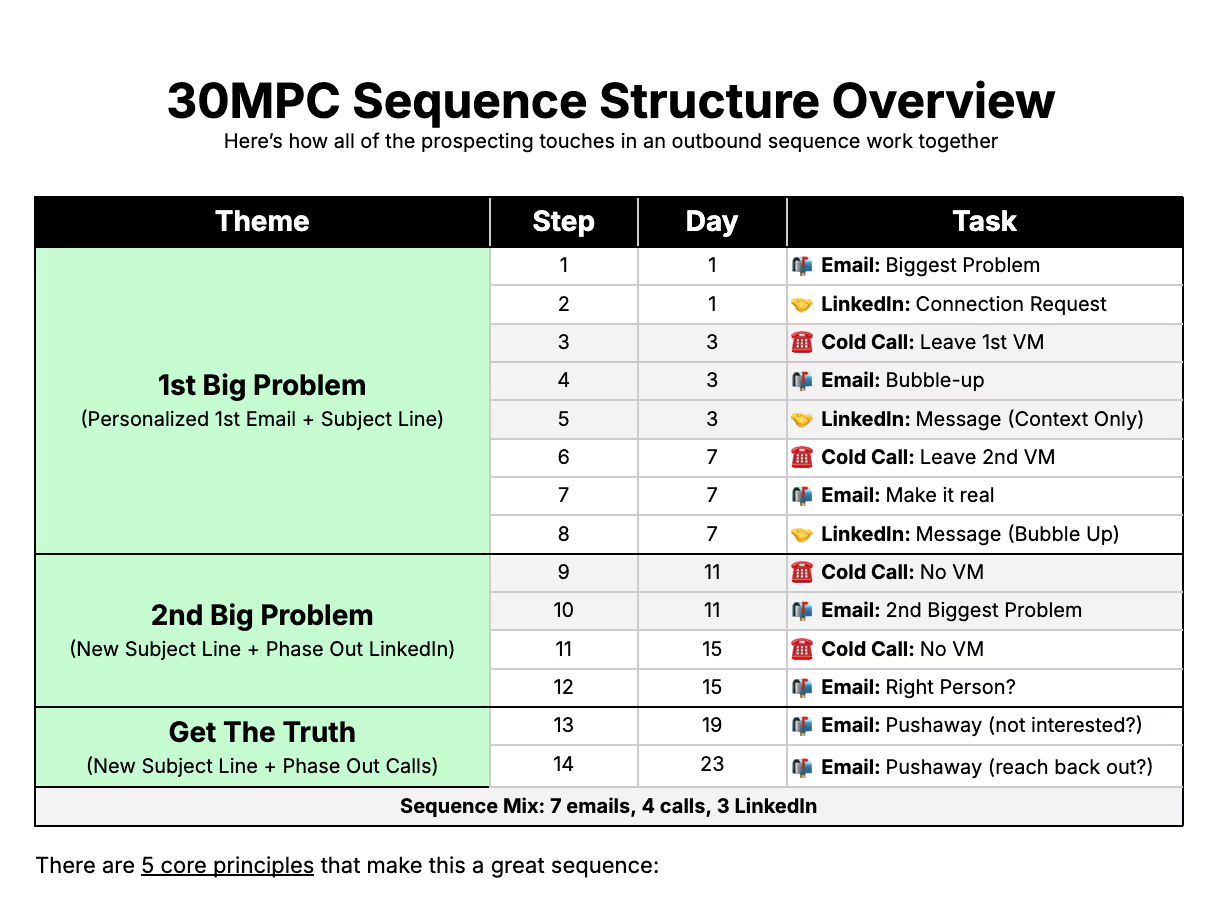Most cold calls end in defeat because everyone uses:
- Canned openers that make you sound like a telemarketer,
- Buzzword-filled pitches that call your product a "single source of truth"
- Pressure-sale objection handling tactics that make a prospect fight even more
When people quit cold calling, it's because their calls sound like this. The prospect immediately categorizes you as a lower-status telemarketer when you're doing the same things that every other telemarketer is doing.
The key to cold calling is to get them to forget that it's a cold call. If you can reveal the human behind the phone, demonstrate authority and industry expertise, and show that you're capable of listening -- you go from reaction to conversation.
So today, we're going to breakdown The Ultimate 30MPC Cold Calling Framework that'll separate you from the pack in just three steps:
- The Context-First Cold Call Openers
- The Problem Proposition
- The Mr. Miyagi Method to Handle Objections
And if you like this, you'll love what's to come in our upcoming book, Cold Calling Sucks (And That's Why It Works).
Let's ride.
Step 1: The Context-First Cold Call Openers
The following cold call openers are complete junk:
- How’s your day?: You know you don't care and they know it too. They'll say "fine, how can I help you...?" (aka: what are you trying to sell me?)
- Bad time?: It’s always a bad time for a busy prospect. The moment you try to call them back, they'll never pick up again. (and this puts you in a position of inferiority)
Everything you do and say on a cold call must be different from the rest.
That's why the only openers that can't be canned lead with context about them.
There are two context-first openers that accomplish this.

Opener 1: The Heard The Name Tossed Around Opener
The Heard The Name Tossed Around Opener leads with the context about how you work with people like them. This establishes yourself as an in-network peer (not a complete rando) within the first 5 seconds of the call.
There are 3 steps:
- Lead with context: The first words that come out of your mouth determine whether or not the prospect listens to anything else you say, so it’s gotta be relevant. Before you even say your name, drop something familiar to them like competitors you work with, peers you know in their region, or a connection to their investor.
- Introduce yourself: Since you provided something familiar to them and there’s a touch of warmth, NOW you’re ready to introduce yourself.
- Ask the question: You’ve shown that you play in their space, you’ve identified yourself, now ask them whether they’ve heard your name tossed around.
To be clear, it does not matter if they've heard your name tossed around. I've used this opener from when I was a no-name 20-year-old life insurance salesman and when I was the 9th employee at Pave. It's about acting like they should have:
- If they say no (most common), Say: “Ha! Guess I’m not as popular as I thought. Well, the reason for my call is…” and roll into your problem proposition (up next).
- If they say yes: You don't need to pitch. Say: "Oh! Well, we'd normally be working with someone like you by now. I guess, what'd you hear?

Opener 2: The Tailored Permission Opener
The Tailored Permission Opener works because it owns that you’re making a cold call and disarms the prospect with brutal honesty.
But there's a twist on the traditional permission-based opener: Lead with context. The untailored PBO sort of blindsides the prospect because you could literally be calling about anything. Plus, it's really popular now, which means prospects will lump you with everyone else who uses it. (Remember: context can't be canned).
There are three steps to this one as well:
- Lead with context: Lead with context related to the problem you solve such as a product launch, funding, or the opening of a new office (you're gonna tie your problem proposition to this context in step 2)
- Own the cold call: It’s really hard to get mad at someone that acknowledges what they’ve done. Break the tension and lean into humor by calling out that you’ve interrupted their day or that this is very clearly a cold call.
- Get permission to pitch: Let them know how long you need and that it’s their call what happens after 30 seconds. I know it feels counterintuitive, but give them perceived control and they'll actually listen to you.
And now you've got permission to pitch. That brings us to step 2.
Step 2: The Problem Proposition
Here's why most traditional value propositions absolutely suck:
- They often include vague telemarketer buzzwords. Phrases like single source of truth, all-in-one platform, and leading provider of X trigger every telemarketer alarm because they're the same generic value phrases that reps use at every company.
- People act on problems more than benefits. Human beings are more motivated to take action to get rid of pain than they are to achieve benefits. If someone has a headache, they’re gonna take the Advil. But they might not take the multivitamin.
- Value has no context without a problem. They won’t care about your titanium-plated nonstick pan if they like their cookware. They will if you remind them that the egg stuck to their pan last week.
You need to describe a problem in such triggering detail that it gets them to sit up and realize why your solution even matters.
That looks like this:

There are three steps to build your own:
- Triggering Problem: To trigger that painful memory, repaint the story as if you were describing a movie scene. Who was there? Where were they? What challenge were they facing? How were they feeling?
- One-Sentence Solution: The magic formula is “we do X so that the problem goes away” where X is your single biggest differentiator that allows you to solve the problem. If you nail the problem, you only need one sentence to make it go away.
- Interest-Based-Call-to-Action: Validate their interest before you ask for a meeting (meetings feel heavy) Starting with a small ask increases your chances of an initial yes, at which point you can shoot your shot on booking the meeting.
The biggest mistake is that sellers aren't specific enough.
I should be able to visualize the problem... and it should be damn triggering.
Step 3: The Mr. Miyagi Method to Handle Objections
.avif)
When handling objections, you must realize that most objections are not objections to your product, but reactions to the interruption itself
You need to handle the reaction before you handle the objection. In Karate Kid, when Mr. Miyagi sees an incoming punch, he waxes-on and waxes-off to redirect its momentum instead of blocking and fighting the punch (or objection) head to head.
Using "No Budget" as an example, there are 3 steps to handling objections like Mr. Miyagi:
1) Agree With The Objection: Objections are often a reaction to the interruption, not your pitch. When you agree with the objection, it feels really dumb to keep fighting someone who isn’t fighting you. That gets them listening instead of reacting:
“I hear ya. Nowadays, it’s hard enough to keep your budget, let alone add something new.”
2) Incentivize Conversation: You still don’t have enough information to handle the objection and they’re still not comfortable enough to hear you out yet. So get them talking and incentivize them to share more by saying… we’re never gonna cold call you again:
“Just so no one calls you again, is it that you’re out of budget for this fiscal year or you get put through the wringer every time you try to buy something?”
3) Sell The Test Drive: You still don’t want to sell your product because that red alert defense mode goes right back up. You want to sell the test drive: why should they take a look at the car, even if they don’t buy it?
“Hey, thanks for opening up. Look, you’re probably not gonna buy this thing now. But if budget ever frees up, the people that get it at least have a directional sense of what they’d want. Open to taking a look, so you at least know what’s out there?”
A Step-By-Step Guide To Calling Strangers

If you liked this, the roadmap above shows you everything else you'll find in our course Cold Calls to President's Club.
Step-by-step breakdowns. Talk tracks for multiple industries. Scripts and voiceovers for 18 objections. And moderately hilarious stories so the concepts sink in.

















